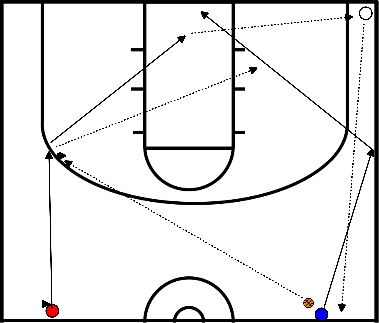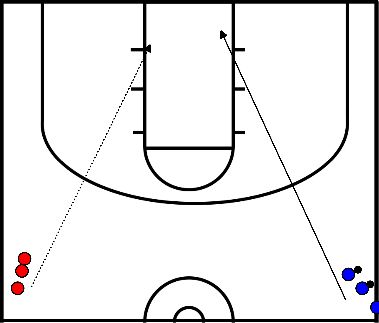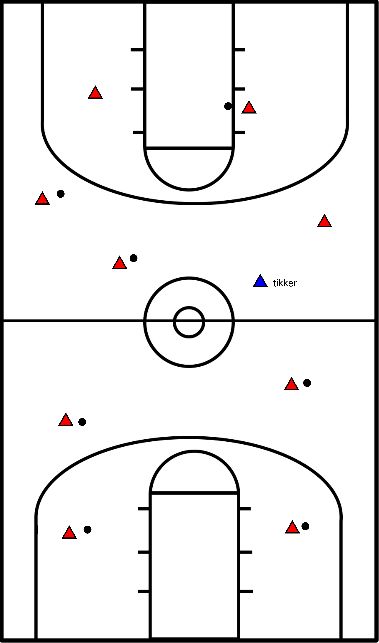Basketball drills for technique warming-up
Two rows on the center line, 1 player in the corner on the baseline (the passer).
Starting with right layups:
- Ball is with the proposal player in the right row
- First player in left row runs to the front
- Player with ball passes ball to player in left row
- Player in left row makes a jump stop
- Player in right row touches sideline at free throw line and makes a cut to the basket
- Player with ball passes to other player at right moment (other player asks for ball)
- Player in right group makes lay-up.
- Player in left row catches ball and passes to player in corner (no ball on the ground!)
- Player in the corner passes ball to next player in line
- Catcher becomes player in the corner

- 10 minutes:
- 5'right
- 5'left
- 2 lines
- right side 2 balls
- Half of players right side
- half of players left side to rebound

Requirements
- paste technique
Organization
- There is one ticker without the ball and two players without the ball.
- Whoever has the ball cannot be tapped without it.
- The ball may be held for a maximum of ten counts.
- If the scapegoat intercepts a ball, the ball is out of the game.
- Change the scapegoat regularly
- Depending on the amount of players adjust the size of the field.
- Running outside is not allowed.
Goal
- Free running, searching for space
- Movement
- The joy of playing
Teaching points
- Passing technique, running free and filling space
- Ball must reach other player, otherwise also out
- Dribble!

- For fitness this is a good exercise:
- The group has to line up and you let them start dribbling slowly.
- As soon as the trainer blows the whistle, the last one in line should run forward.
- Do this until everyone has run and then let them finish the circle.
Everyone a ball
- Outward zig/zag dribble around pawns and finish with lay-up
- Back various assignments (Crabwalk, backwards dribble, between the legs) and also finish with lay-up
- start quietly as a warming-up, then faster and faster
- Coach lining up at the return to give various assignments.
- There is one scapegoat without the ball and two players without the ball.
- The ball is thrown over in a good position, who has the ball can be tapped without the ball.
- The ball may be held for a maximum of ten seconds.
- If the ticker has intercepted a ball, then that ball goes out of the game.
- Are you tapped you go to the side when no 2 comes on the side does no 1 again.
2 rows, 1 ball per team
- Player scores, rebounds own ball, and passes to next player in line
- Player who scored runs to the other baseline to retrieve a pawn and brings it back to the group. Can also be done with the volleyball scoreboard (keeping track of points, best of 5)
- Group with most pawns at the end wins
- Two lines,
- one a meter behind mid-court,
- other behind circle on defense side.
- Two balls in middle
- Two hard dribbles, jump stop, pass for layup.
- Everyone a ball, line up in a large circle.
- Trainer shows the exercise, players follow:
- Spread out, rolling the ball in an 8-shape between the legs
- Roll the ball around your waist, head legs (change direction)
- Dribble with left, right, change hands.
- Dribble with the whole group (rhythm exercise, all in rhythm!)
- Dribble between your legs
- Dribble behind your back
- Shot movement upwards (extend arm, point, catch)
- Spreading stance (move the ball in an 8-shape without touching the ground)
- Ball above your head, passing with fingertips from left to right
- Pairs face each other.
- Ball between them.
- Players stand with their hands behind their backs.
- As soon as BAL is called they try to grab the ball as fast as possible.
- Who catches it first, wins.
- In the field there are all sorts of obstacles, such as mats, hoops and cones.
- The trainer walks in front along these obstacles, the children follow him.
- Variation
- The children walk in pairs along the obstacles.
- They walk backwards.
- They walk with sideways steps.
- The children walk in pairs through the room.
- One child tries to follow the other.
- Variation
- The child in front has to change pace suddenly.
- The child in front has to change direction sharply.
- Groups of four or five children.
- Groups of four or five children and on signal the back one sprints to the front and then indicates the track.







